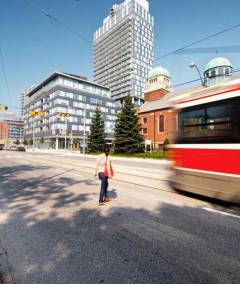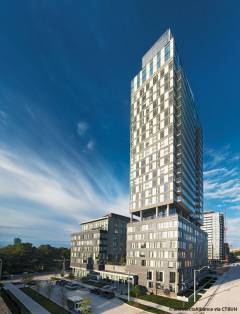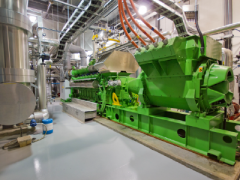Client: Toronto Community Housing /Regent Park Energy Inc.
Owner/Operator: TCHC / Corix, Ameresco, EnerFORGE
Year: 2005 to Present
Project Highlights
- Urban Energy Center Integrated into the First Residential Tower
- Campus Electricity & CHP System improves Energy Efficiency and provides Sustained Occupancy
- Building Driven Low Temperature Hot Water System Design
Regent Park Revitalization Transforms One of the Oldest & Largest Housing Projects into an Environmental Conscious Future Proofed Community
Toronto Community Housing Corporation (TCHC) embarked on a bold and exciting revitalization plan over 15 years ago to rebuild a new and energy conscious, socially responsible community. The result was the incorporation of a low temperature hot water and chilled water district energy system to serve all of the space heating, domestic hot water heating and space cooling needs of all buildings in the redevelopment. The low temperature design provides flexibility to incorporate waste energy streams into the production facility.
The Regent Park Energy System also incorporates a campus electric microgrid with islanding capabilities to provide community resilience and meet TCHC’s sustained occupancy goals.
FVB Energy was responsible for the detailed design, tender, and construct support of the Energy Centre at 252 Sackville Street, with 35 MW hot water heating plant and 4,000 ton chiller plant including the installation of 4.8 MW Combined Heat and Power System (2.8 MW CHPSOP & 1.4 MW PSUI). FVB also designed the 3,500 m of distribution piping network and 30 energy transfer station customer connections over the last 15 years.
Quick Stats
- trench meters of installed piping: 3500 m
- building connections: 30+
- sqm served: ~8,000,000 full buildout
- MW of heating plant built: 35 (up to 45 MW full buildout)
- tons of cooling plant built: 4000 (up to 6000 tons)
- MWe CHP: 4.8 MW
- GHG reductions (tonnes CO2): 8000 tonnes/year
More Information
Visit EnerFORGE
Visit Regent Park
Keywords
Detailed design, CHP, DPS, ETS,CHP, Campus Electrical Microgrid, Sustainable Occupancy








